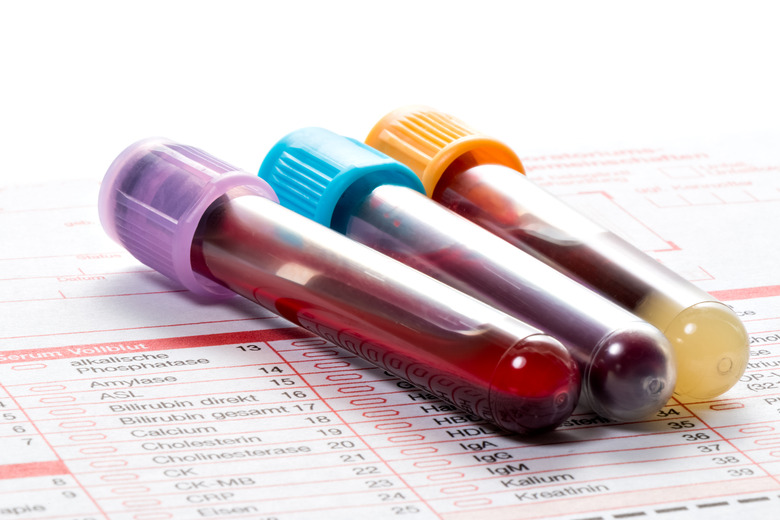How A Cell's Shape Affects Its Function
From the moment a human zygote is formed, the cells are busy dividing and specializing into the many different types of cells they will become. These specialized cells will perform numerous functions in the human body, from digestion and excretion to message transmission and oxygen distribution. The structure of each type of human cell depends on what function it will perform in the body. A direct relationship exists between the size and shape of every cell and the tasks it needs to accomplish.
TL;DR (Too Long; Didn't Read)
The structure and shape of each type of human cell depends on what function it will perform in the body. For example, red blood cells (RBCs) are very small, flat discs, which allows them to easily fit through narrow capillaries and around sharp corners in the circulatory system to deliver oxygen throughout the body.
Neurons carry messages from the brain and spinal cord to the rest of the body, using electrical signals down their lengths and chemical signals between neurons. Since electrical signals travel much faster than chemical signals, neurons are long and thin to minimize the number of slower chemical signals that would be required between links in a chain of many shorter neurons.
The elongated shape of muscle cells allows the contraction proteins to line up in an overlapping pattern that makes muscle flexing possible.
And human sperm cells' structures allow them to "swim" long distances to reach an egg for fertilization. They do this by using flagella, their long whip-like tails, and also by being very small, carrying little more than the DNA for a potential zygote.
Red Blood Cells
Red Blood Cells
Red blood cells carry the protein hemoglobin, which attaches to oxygen and delivers it to all of the body's tissues. Red blood cells are flat, round and very small, allowing them to easily turn corners with the flow of the blood and fit through the capillaries, the tiniest blood vessels, where oxygen is transferred to body cells.
Nerve Cells
Nerve Cells
Nerve cells, or neurons, carry electrical messages to and from the brain and spinal cord, helping the body respond to various stimuli, regulate mechanisms, and absorb and store information. To most efficiently transmit these electrical messages, neurons have a long, thin structure, allowing for very quick and accurate communication and responses. Length is beneficial to the structure of a neuron because electrical messages within a neuron travel more quickly than the chemical messages between neurons. Thus, a few longer neurons means faster transmission of signals than a chain of many shorter neurons.
Muscle Cells
Muscle Cells
Skeletal muscle cells are arranged in bundles of linear fibers. A single muscle cell is elongated in shape, containing within it many myofibrils. These are thin strands made of the proteins actin and myosin that perform muscle contraction. The elongated shape of muscle cells allows the contraction proteins to line up in an overlapping pattern that makes muscle flexing possible. Nuclei and other organelles that are normally within a cell lay at the perimeter of muscle cells, making space for the ordered patterns of the proteins.
Sperm Cells
Sperm Cells
Sperm cells in males are the only human cell with flagella, or whiplike cell extensions. This is because of their need to "swim" long distances to reach an egg for fertilization. Also due to their need to travel, the body of a sperm cell is very light, carrying not much more than the chromosomes containing the DNA for a potential zygote. The other organelles that are found in most other body cells are nonexistent in sperm cells, and are given to a zygote by its mother's egg.
References
- National Institute of General Medical Sciences; Inside the Cell; Alison Davis
- National Center For Biotechnology Information: Shape and Biomechanical Characteristics of Human Red Blood Cells in Health and Disease
- The Alcohol Pharmacology Education Partnership: Neuron Structure and Function
- National Center For Biotechnology Information: Molecular Biology of the Cell – Sperm
- Austin Community College: Muscle Cell Anatomy & Function
Cite This Article
MLA
Celebi, Sarah. "How A Cell's Shape Affects Its Function" sciencing.com, https://www.sciencing.com/cells-shape-affects-its-function-8600698/. 10 July 2019.
APA
Celebi, Sarah. (2019, July 10). How A Cell's Shape Affects Its Function. sciencing.com. Retrieved from https://www.sciencing.com/cells-shape-affects-its-function-8600698/
Chicago
Celebi, Sarah. How A Cell's Shape Affects Its Function last modified March 24, 2022. https://www.sciencing.com/cells-shape-affects-its-function-8600698/
